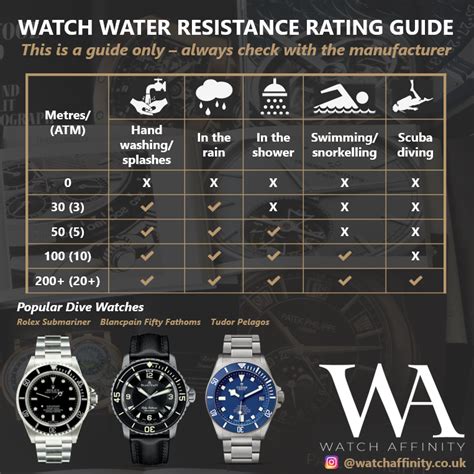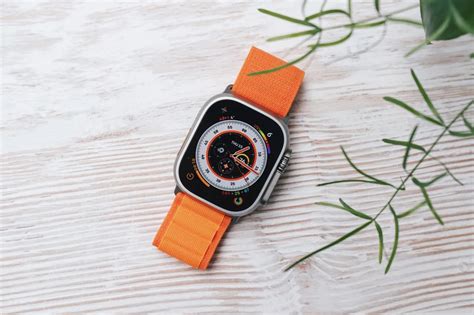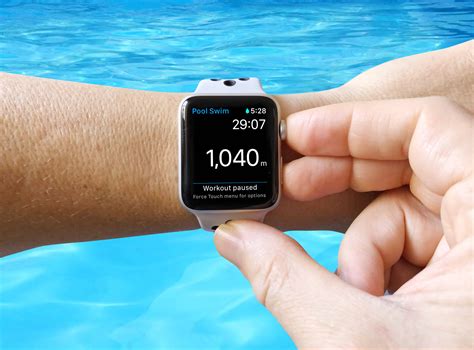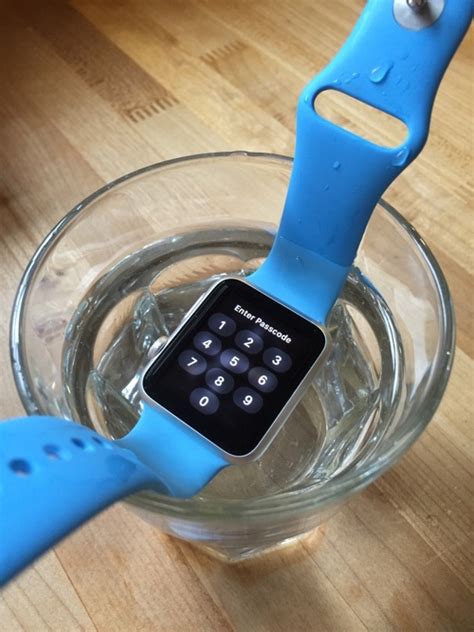Have you ever wondered if you can take a dive in the pool or swim in the open water while wearing your cherished Apple smartwatch? This question has been on the minds of many tech enthusiasts and fitness enthusiasts alike. However, considering the delicate nature of these cutting-edge devices, one might question their compatibility with aquatic activities.
One of the most intriguing aspects of Apple watches is their extensive range of features and capabilities. From heart rate monitoring to GPS tracking, these sleek devices have become an essential tool for many people pursuing an active lifestyle. But what about swimming? Can these innovative gadgets withstand the challenges posed by water, chlorine, and the salt from the ocean?
It is a known fact that water and electronic devices are not the best of friends, and the delicate components of most gadgets do not fare well when exposed to moisture. However, Apple has taken substantial steps to ensure that their watches can withstand water-related activities. With their advanced design and water-resistance technology, these timekeepers are equipped to handle various water-related scenarios, including swimming.
Water Resistance of Apple Watches Explained

Understanding the water resistance capabilities of the Apple Watch is crucial for those who want to use it in water-related activities. In this section, we will delve into the details of the Apple Watch's ability to withstand water and explain what it means for users.
1. Water Resistance Ratings:
- The Apple Watch Series 2 and newer models come with a water resistance rating of 50 meters, suitable for swimming and water sports.
- With a water resistance rating of 50 meters, the Apple Watch can be safely submerged in water without worrying about damage or malfunction.
- It is important to note that although the Apple Watch is water-resistant, it is not designed for activities like scuba diving or high-velocity water sports.
2. Water Resistance vs. Waterproof:
- While the terms "water-resistant" and "waterproof" are often used interchangeably, they have distinct meanings.
- A water-resistant Apple Watch can handle exposure to water to a certain extent, but it is not completely impervious to water.
- Waterproof devices, on the other hand, are designed to be completely sealed against water and can withstand submersion without any damage.
3. Swimming with Your Apple Watch:
- Thanks to its water resistance rating, you can confidently swim or engage in water activities while wearing your Apple Watch.
- However, it is important to ensure proper care and maintenance of the watch after swimming to avoid any potential issues.
- Rinsing the watch with freshwater and drying it thoroughly is recommended to remove any residue or potential damage caused by saltwater or chlorine.
4. Limitations and Precautions:
- While the Apple Watch is designed to be water-resistant, it is important to remember its limitations.
- Avoid exposing the watch to high-velocity water, such as waterskiing or diving into a pool, as it may exceed the water resistance capabilities.
- Additionally, extreme temperature changes and exposure to soaps, shampoos, or other chemicals should be avoided to prevent any potential damage.
In conclusion, the Apple Watch's water resistance rating of 50 meters makes it suitable for swimming and water-related activities. Understanding the difference between water resistance and waterproofing is essential to ensure the proper usage and care of your Apple Watch. By following the recommended precautions, you can confidently enjoy your Apple Watch in various water environments without worrying about its functionality.
Understanding the IPX Rating System
Exploring the Ins and Outs of the IPX Rating System for Water Resistance
When considering the compatibility of smartwatches, such as the popular Apple Watch, for aquatic activities, it is crucial to understand the IPX rating system. The IPX rating system, also known as the Ingress Protection rating system, provides valuable insights into the degree of protection a device offers against water and dust intrusion.
Strongly associated with consumer electronics, the IPX rating system evaluates the level of water resistance provided by a device. It assesses the ability of electronic gadgets, like smartwatches, to withstand various water-related activities, including swimming, diving, or simply being exposed to rain and splashes.
The IPX rating system consists of two digits, each representing a specific level of protection. The first digit reflects the device's protection against solid particles, such as dust and dirt, while the second digit denotes its resistance to water. These digits range from 0 to 9, where 0 indicates no protection and 9 signifies the highest degree of protection.
For example, a device with an IPX7 rating would have a level 7 water resistance, meaning it can withstand immersion in water up to a depth of 1 meter for 30 minutes. On the other hand, a lower rating would indicate a lower level of water resistance, requiring greater caution and limited exposure to water activities.
Understanding the IPX rating system is crucial when considering whether an Apple Watch or any smartwatch is suitable for swimming. While some devices may boast a water resistance rating, it is essential to match the IPX rating with the intended water activities to ensure its capabilities align with the user's needs.
Therefore, before engaging in aquatic activities with any smartwatch, it is wise to familiarize oneself with the IPX rating associated with the specific device to make an informed decision and guarantee a worry-free experience in the water.
In conclusion, comprehending the IPX rating system empowers individuals to assess the water resistance capabilities of smartwatches, like Apple Watches, for swimming or other water-related activities. By understanding the two-digit code and its implications, users can confidently determine whether a device is suitable for their intended aquatic adventures.
Performing in Water: A Closer Look at Apple Watches

When it comes to their abilities in aquatic environments, Apple Watches truly prove their mettle. Submersible, water-resistant, and capable of withstanding the challenges of swimming and other water-related activities, these innovative devices stand as reliable companions for users seeking to incorporate their technology into their aquatic adventures.
Apple Watches exhibit remarkable performance underwater, allowing users to track their swimming metrics and monitor their progress with precision. Equipped with advanced sensors and technology, these watches provide accurate measurements of distance covered, stroke count, calories burned, and other key metrics relevant to swimming.
Not only do Apple Watches excel in recording metrics, but they also ensure durability and water resistance. With a high level of water resistance specified by Apple, users can confidently dive into various water bodies, including pools and open water, without worrying about damaging their device. The water resistance rating ensures protection against splashes, submersion, and even pressure at certain depths, enabling users to explore different depths under water.
In addition to the device's inherent capabilities, Apple also offers specialized swimming workouts through their fitness apps, tailored specifically for water-based activities. Users can select from a range of swimming workouts, including interval training, long-distance swimming, and stroke improvement, all of which can be tracked and monitored directly from their Apple Watch.
Apple's commitment to ensuring reliable functionality underwater is also reflected in their continuous improvement and updates to their devices and software. With each new generation of Apple Watches, the water resistance capabilities and swimming-related features are enhanced, granting users a seamless and enhanced swimming experience.
In conclusion, Apple Watches showcase exceptional performance in aquatic environments, making them suitable companions for swimmers and water enthusiasts. With their ability to accurately track swimming metrics, high water resistance ratings, and dedicated swimming workouts, it's no wonder Apple Watches have become a popular choice for those looking to elevate their aquatic adventures.
Swim-Tracking Features of Apple Watches
In this section, we will explore the functionality provided by Apple Watches when it comes to monitoring and tracking swimming activities. The technological capabilities of these devices enable users to keep track of various aspects of their swimming sessions, allowing for a comprehensive analysis of their performance and progress.
Designed for water-based activities: Apple Watches are specifically engineered to be water-resistant, making them suitable for swimming and other water-related activities. This means you can dive into the pool or the ocean without having to worry about damaging your device.
Tracking swimming metrics: The swim-tracking features of Apple Watches offer a range of metrics that provide insights into your swim sessions. These metrics include stroke count, distance covered, lap times, average pace, and calories burned. By keeping a record of this information, users can monitor their progress, set goals, and make adjustments to their swimming routine accordingly.
Automatic stroke recognition: Apple Watches employ advanced algorithms to automatically recognize different swim strokes, such as freestyle, backstroke, breaststroke, and butterfly. This feature ensures accurate tracking of different swimming techniques, allowing users to get detailed feedback on their stroke efficiency and identify areas for improvement.
Water lock mode: To further enhance its water resistance, Apple Watches come equipped with a water lock mode. This mode disables the touch screen to prevent accidental interactions while swimming, ensuring that the device remains fully functional and protected from water damage.
Health and fitness integration: Along with swim-specific features, Apple Watches seamlessly integrate with its health and fitness apps. This integration allows users to view their swimming data alongside other fitness metrics like heart rate, calories burned, and activity rings, providing a holistic overview of their overall health and fitness levels.
Third-party app support: In addition to the built-in swim tracking features, there are also various third-party apps available for Apple Watches that offer more advanced swim tracking capabilities. These apps can provide personalized coaching, detailed analysis of swimming technique, and even social features that allow users to connect with fellow swimmers and participate in challenges.
In conclusion, Apple Watches offer a comprehensive range of swim-tracking features that cater to the needs of swimmers at different skill levels. From basic tracking metrics to advanced stroke recognition and third-party app support, these devices enable users to fully maximize their swimming experience and enhance their performance in the water.
Tips for Using Your Apple Watch While Swimming

Swimming with your Apple Watch can be an enjoyable and convenient way to track your workouts and monitor your progress. However, it's important to take precautions to ensure the safety and functionality of your device. Here are some helpful tips to make the most of your swimming experience with your Apple Watch:
| Tip | Synonym |
|---|---|
| 1 | Preparation |
| 2 | Waterproof Check |
| 3 | Water Resistance Ratings |
| 4 | Choose the Right Pool |
| 5 | Lock Your Screen |
| 6 | App Selection |
| 7 | Track Your Swim |
| 8 | Post-Swim Care |
First and foremost, it is important to properly prepare before swimming with your Apple Watch. This involves ensuring that your device is securely fastened and that you have selected the appropriate swimming tracking app.
A waterproof check is essential to confirm that your Apple Watch is capable of being submerged in water. Water resistance ratings give you an idea of how resistant your device is to water and can help you determine if it is suitable for swimming.
When swimming with your Apple Watch, it is important to choose the right pool. Avoid pools with excessively high water temperatures or chemicals that may damage your device. Additionally, always remember to lock your screen to prevent accidental touches while in the water.
App selection is another important consideration. There are various swimming tracking apps available that can help you monitor your swim metrics, such as distance covered, time elapsed, and calories burned.
After your swim, it is crucial to take proper care of your Apple Watch. This includes rinsing it with fresh water to remove any chlorine or salt residues and wiping it dry with a soft cloth to prevent any moisture or damage to the device.
By following these tips and taking the necessary precautions, you can confidently enjoy swimming with your Apple Watch while ensuring its longevity and functionality.
Potential Risks of wearing Apple Watches while Engaging in Water Activities
Swimming with your Apple Watch may seem like a convenient way to track your workouts and stay connected, but there are certain potential risks associated with this activity. It is important to be aware of these risks to make informed decisions about wearing your Apple Watch in water.
- Water Damage: Exposing your Apple Watch to water increases the risk of water damage. While Apple Watches are water-resistant, they have specific limitations, and prolonged submersion or exposure to high-pressure water could result in the device being damaged. Therefore, it is crucial to understand the water resistance level of your specific Apple Watch model and avoid exceeding its recommended water resistance limits.
- Chemicals and Potential Corrosion: Swimming pools, hot tubs, and even saltwater can have chemicals that may have a negative impact on your Apple Watch. Chlorine or saltwater can potentially corrode the components, leading to malfunctioning of the device. It is advisable to rinse your Apple Watch thoroughly with fresh water after swimming in any chemically treated or salty water conditions to minimize potential corrosion.
- Strap and Buckle Damage: Swimming vigorously or in rough waters may cause the strap or buckle of your Apple Watch to become loose or even break. This could result in losing your watch during the activity. Therefore, it is recommended to ensure that your strap and buckle are securely fastened before entering the water and to periodically check their condition during swimming sessions.
- Heart Rate Monitoring Accuracy: Apple Watches use sensors to monitor heart rate during workouts, including swimming. However, the accuracy of heart rate monitoring may be compromised when the watch is submerged in water. Factors such as water pressure and the tightness of the band can affect the readings. It is important to be aware of potential inaccuracies and use other means, such as manual pulse checks, for a more accurate heart rate assessment when swimming.
- Increased Risk of Accidental Damage: Engaging in water activities inherently involves a higher risk of accidental damage to your Apple Watch. Activities like diving, water sports, or encountering rough surfaces can potentially lead to scratches, impacts, or falls, which may impact the functionality and aesthetics of the device.
Overall, while Apple Watches offer water resistance features, it is essential to understand the limitations and potential risks associated with swimming or engaging in water activities with these devices. By being aware of these risks, properly maintaining your Apple Watch, and taking necessary precautions, you can minimize the potential damage and enjoy your water activities with peace of mind.
Frequently Asked Questions about Using Apple Watches in Water

In this section, we aim to address some common inquiries regarding the usage of Apple Watches in aquatic environments. Here, we will provide answers to various concerns you might have about wearing your Apple Watch while engaging in water activities.
1. Can I wear my Apple Watch while swimming?
- Is it safe to use my Apple Watch in water?
- Can I submerge my Apple Watch in water?
2. What water-related activities can I do with my Apple Watch?
- Is it suitable for surfing, snorkeling, or diving?
- Can I wear my Apple Watch while participating in water sports like water polo or water skiing?
3. How waterproof is the Apple Watch?
- What is the water resistance rating of the Apple Watch?
- How deep can I take my Apple Watch underwater?
4. Are there any limitations when using the Apple Watch in water?
- Is there a recommended water temperature range for using the Apple Watch?
- Are there any specific care instructions for the Apple Watch after being exposed to water?
5. Will wearing the Apple Watch in water affect its functionality?
- Can I still use the touch screen while my Apple Watch is wet?
- Will water damage the sensors or other components of the Apple Watch?
Remember, while the Apple Watch has water resistance capabilities, it is essential to follow the guidelines provided by Apple to ensure the longevity and proper functioning of your device.
FAQ
Can I go swimming with my Apple Watch?
Yes, you can swim with your Apple Watch. The Apple Watch Series 2 and later models are water-resistant up to 50 meters, so you can wear it while swimming in a pool or open water.
Is it safe to wear my Apple Watch while swimming?
Yes, it is safe to wear your Apple Watch while swimming. The swim-proof design ensures that it can withstand immersion in water. However, Apple recommends rinsing the watch with clean water after swimming in saltwater or chlorine to prevent any potential damage to the device.
What features does the Apple Watch offer for swimmers?
The Apple Watch offers several features for swimmers, including tracking your swimming distance, pace, and active calories burned. It also provides real-time heart rate monitoring, stroke detection, and even offers a Swim Workout app for more precise tracking of your swimming sessions.
Can I wear my Apple Watch while diving or snorkeling?
No, it is not recommended to wear your Apple Watch while diving or snorkeling. Although it is water-resistant, it is not designed for deep-water activities such as scuba diving. The water pressure at greater depths can exceed the watch's capabilities and cause damage.




